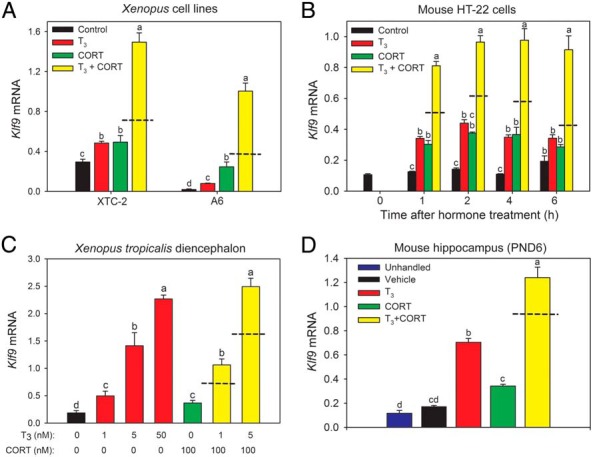Figure 1.

TH and CORT act synergistically to induce Klf9 mRNA in frog and mouse. A, Hormone-dependent Klf9 gene expression in X. laevis cell lines. We treated the X. laevis embryonic fibroblast (XTC-2) and renal epithelium (A6)-derived cell lines (n = 4–6/treatment) with vehicle, T3 (5nM), CORT (100nM), or T3 plus CORT for 4 hours before harvesting for RNA isolation. Hormone treatment caused statistically significant increases in Klf9 mRNA in both cell lines. XTC-2, T3: 1.6-fold; CORT: 1.6-fold; T3 + CORT: 5-fold; F(3,15) = 85.01, P < .01; A6, T3: 4-fold; CORT: 12-fold; T3 + CORT: 53-fold; F(3,15) = 93.59, P < .01; ANOVA. B, Hormone-dependent Klf9 gene expression in the mouse hippocampus-derived cell line HT-22. We treated HT-22 cells (n = 4–6/treatment) with vehicle, T3 (30nM), CORT (100nM), or T3 plus CORT for different times before harvesting for RNA extraction. Hormone treatment caused statistically significant increases in Klf9 mRNA (F(3,15) = 42.36, P < .001; ANOVA): T3: 2.4-fold; CORT: 2.7-fold; T3 + CORT: 6.5-fold; 1 hour: F(3,15) = 216.5, P < .001; 2 hours: F(3,15) = 17.6, P < .01; 4 hours: F(3,15) = 68.26, P < .001; 6 hours. C, Hormone-dependent Klf9 gene expression in early prometamorphic (Nieuwkoop-Faber stage 52–54) X. tropicalis tadpole brain (diencephalon). We treated tadpoles (n = 6/treatment) with T3 and CORT at the doses indicated in the graph for 24 hours (hormones replenished at 12 hours), collected brains and microdissected the diencephalon for RNA extraction. Hormone treatment caused statistically significant increases in Klf9 mRNA (F(6, 41) = 47.99, P < .001; ANOVA): 1nM T3: 2.67-fold; 100nM CORT: 2-fold; 1nM T3 + 100nM CORT: 5.75-fold; 5nM T3 + 100nM CORT: 13.5-fold. D, Hormone-dependent Klf9 gene expression in the hippocampus of PND6 wild-type C57/BL6J mice. Mice were left unhandled, or were given ip injections of vehicle (corn oil + EtOH 0.05%), T3 (25 μg/kg BW), CORT (14 mg/kg BW), or T3 plus CORT. One hour after injection, mice were killed, and the hippocampal region was dissected for RNA extraction (n = 5–6/ treatment). Hormone treatment caused statistically significant increases in Klf9 mRNA (F(4, 25) = 121.4, P < .01; ANOVA): T3: 3-fold; CORT: 1.5-fold; T3 plus CORT: 7-fold. In all experiments, total RNA was analyzed for Klf9 mRNA levels by RT-qPCR using TaqMan assays. The Klf9 mRNA levels were normalized to the reference genes rpL8 (frog) and Gapdh (mouse), which were unaffected by hormone treatment (data not shown). Tissue culture experiments were repeated 3–4 times. Bars represent the mean ± SEM, and letters above the means indicate significant differences among treatments (means with the same letter are not significantly different; Tukey's multiple comparison test; P < .05). Dashed lines indicate the calculated additive effect of combined hormone treatment.
